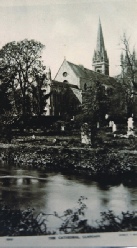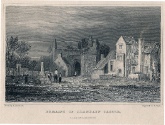Llandaff -





The construction of the weir, where previously there had been rapids, to the north of the Cathedral, made the new course of the Taff a permanent one. The wandering course of the river hindered any early development of the low-
The City -
When St Augustine, the first archbishop of Canterbury arrived in Kent in 597 AD, a Christian church or saint’s cell had probably been in existence in Llandaff for about a century. Excavations have revealed the presence of pagan burials (probably Romano-
The early importance of Llandaff as a religious site is explained, partially at least, by its location at the lowest point at which the river could be easily crossed. Long before the coming of the Roman legions, there appears to have been an important track way leading from the west, across the Vale of Glamorgan, to the east. The River Taff was probably tidal as far north as Llandaff and natural springs near the present site of the Cathedral, would have made the river crossing at Llandaff a convenient place to stop. The ancient track way to the east can still be followed from Cowbridge Road West, Ely Road, High Street and down the steep land to the Cathedral, where it comes to an abrupt stop.
The route of the ancient track way was probably followed by the Romans when they first constructed their military highway westwards from Caerleon through the area to link the coastal forts. Only later would the route be changed to reach the fort at Cardiff, when it was rebuilt in the third century. But evidence has been discovered that there was a route connecting the Roman fort and Cardiff to iron workings in the Llantrisant area, passing through Llandaff.
Tradition claims that St Germanus of Auxerre visited Llandaff and consecrated his pupil Dyfrig (St Dubritius) to the Archbishopric at about 427 AD. According to The Book of Llandaff, however, the principal founder of the Cathedral was St Teilo at about 512 AD. The only reminder of the pre-

2
2